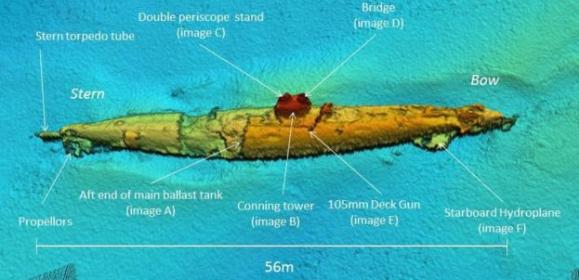
Multibeam View of the Wreck of UB85, Image: Scottish Power
Engineers laying subsea power cables off Stranraer, Scotland have discovered the wreck of a World War I German UBIII-Class submarine, which may be either the UB-85 or the UB-82, both of which were sunk in the area. The possibility that the submarine may be the UB-85 has set the media and the internet abuzz, because according to legend, the UB-85 was sunk after being attacked by a sea monster. Some have even identified the creatures as the Loch Ness monster, or at least its salt-water cousin. International Business Times led with the headline “Did Nessie help win the war? German U-boat ‘sunk by sea monster’ discovered off Scottish coast.”
To be clear, the German submarine UB-85 was sunk by HMS Coreopsis, an Anchusa-class sloop, and definitely not a sea monster. There are two versions of the sinking. Both start with the submarine charging its batteries on the surface on April 30, 1918.
In the official version, HM Coreopsis spotted UB-85 and began an attack. The submarine unsuccessfully attempted a crash dive, but flooding though a partially closed hatch forced it back to the surface. The crew abandoned the sub under British fire. There were no causalities and the submarine crew of 34 were taken as prisoners of war.
The colorful version of the tale is reported to have been told by the submarine captain, Günther Krech. Captain Krech said that while charging batteries, he and several of the crew were on deck to get some fresh air, when a huge sea beast climbed onto the starboard bow of the submarine, causing the sub to list dramatically. The creature climbed aft until it reached the forward gun mount and began to bite the deck gun with its substantial teeth. The captain described the creature: “This beast had large eyes, set in a horny sort of skull. It had a small head, but with teeth that could be seen glistening in the moonlight. Every man on watch began firing a sidearm at the beast, but the animal had hold of the forward gun mount and refused to let go.” At some point, the creature became tired of being shot, let go of the deck gun, and slid back into the cold and dark waters. According to the captain, the weight of the beast on the forward deck so damaged the submarine that it was incapable of submerging, which was why the Coreopsis was able to catch it on the surface.
The sea monster version has appeared in several books and has spread across the Internet. It did not, however, appear in the Coreopsis ship’s log or apparently have any other corroboration. Somehow, I doubt that there are observable teeth marks on the deck gun.
There is one other German submarine-sea monster story from World War I. In this case the submarine attacked the sea monster instead of the the other way round. In July 1915, shortly after the German submarine UB-28 sank the British steamer Iberian, there was a underwater explosion, presumably the steamer’s boilers exploding. The submarine captain, Baron Georg-Günther Freiherr von Forstner claimed that “a gigantic sea-animal, writhing and struggling wildly … shot out of the water to a height of 60 to 100 feet.” It “had a long, tapering head and a long body with two pairs of legs. Its length may have been some 20 metres. In shape, it was more like a crocodile than anything else.”
Baron von Forstner apparently first mentioned this remarkable creature in an article he wrote for the Deutschen Algemeine Zeitung in 1933. The article was notionally about the Loch Ness monster, which had been sighted several times that year, and was all the rage. Why the Baron failed to mention the UB-28’s crocodilian sea beast for 18 years or to record it in the submarine’s Kriegstagebücher (war diary) is unclear. Also, 61 of the Iberian’s crew made it to the boats and were subsequently rescued. None mentioned a flying sea monster.
Perhaps the focus on unknown sea beasts misses the point. In World War I, submarines were a new and terrifying technology, sea creatures rising from the deep to sink ships. As Dr Innes McCartney, a historian and nautical archaeologist who helped identify the wreckage of what may be UB-85 commented: “The true sea monsters of the first world war were the submarines themselves.”

“Das Boot” was about a funky WWII German sub, think of how funky it was in the WWI version of a sub. They should make a movie about a U-boat of that period. I wonder if they had something like rum rations in those boats?